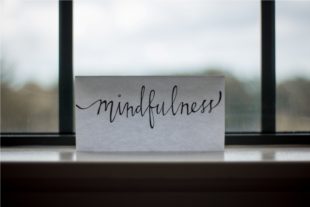The “M” Word: How Mindfulness Can Impact Emotional and Spiritual Growth
Christian Counselor Spokane
When my first-born daughter was only a few days old, I was navigating the hilly, winding streets of Seattle in a sleep-deprived malaise intermingled with a glowing pride typical of new fathers. My daughter was buried in blankets in her shiny new car seat.
 My wife was riding shotgun, glancing back at our beautiful girl every other second with an exhausted adoration typical of new mothers. We were on our way back home from the grocery store, and I was in something of a reflective (if grandiose) mood. I decided on that car ride home that I would become the best father known to humanity.
My wife was riding shotgun, glancing back at our beautiful girl every other second with an exhausted adoration typical of new mothers. We were on our way back home from the grocery store, and I was in something of a reflective (if grandiose) mood. I decided on that car ride home that I would become the best father known to humanity.
Then it happened.
I took a wrong turn. This was a common occurrence in Seattle, as the roads are somewhat labyrinthine, and I had not lived in this soggy city long enough to learn the random swerves and hard lefts just yet. Regardless of the fact, wrong turns had become as routine as right turns, the blunder still frustrated me, a frustration that only ballooned as I attempted to right the ship and find my way back onto the main thoroughfare.
Any Seattle native can tell you this is no easy task! A few too many grumbles later, I was back on track, grumpier than before but otherwise recovered. I returned to my musings about becoming the best father known to man –
Then it happened.
Someone roared into my lane, cutting me off and fire-hosing my windshield while they were at it! I had to swerve left to avoid a collision on the right side of my vehicle – the side my daughter was sitting on. I snapped. I saw red. I lost it. Any other cliché you can think of to describe pure, unadulterated fury: that was me.
The wild, overprotective father in me pushed aside the calm, reasonable therapist in me and took the wheel. He hit the gas, intent on catching up to the culprit and… and… and… I’m not exactly sure what, but they would be sorry!
After weaving in and out of traffic for a few seconds, he regained his sense of hearing, only to realize that his wife was shouting incomprehensible words at him. Only a mother’s overprotective fury can eclipse a father’s. I snapped out of it. I came to my senses. I got a grip. Any other cliché you can think of to describe regaining one’s composure: I did that.
A rush of emotions followed my return to planet Earth. Shock. Shame. Sorrow. You name it. After apologizing to my wife (she forgave me) and my daughter (she forgave me too), I couldn’t help but ask the big question: how could this have happened? How could a mature, thoughtful adult lose all sense of control over his thoughts, emotions, and actions?
 The truth is that this loss-of-control phenomenon is not a phenomenon at all. It happens all the time, to so many of us, in so many situations, on so many distinct levels.
The truth is that this loss-of-control phenomenon is not a phenomenon at all. It happens all the time, to so many of us, in so many situations, on so many distinct levels.
Most of us can relate to my Fast and the Furious moment. After all, our automatic shift into “fight or flight” mode in response to a real (or perceived) threat is built into our genetic code. This process kept us alive for centuries. While we live in a world in which wild animals are much less likely to eat us for dinner, our genes haven’t exactly caught up with the times.
In other words, we tend to shift into fight or flight mode in response to any number of (what our brains perceive to be) threats in the environment, whether the new “wild animals” come in the form of a sense of powerlessness over the future, the chronic stress of an invalidating workplace, or the loss of something or someone you treasure most. Not only that, when we get stuck in fight or flight mode, our ability to regulate emotions breaks down over time.
Whether a loss of emotional control leads to overblown frustration following a wrong turn or a full-blown vigilante road rage moment following a narrow escape, we tend to come out on the other side of emotional dysregulation with feelings of shame and regret.
How can I become the best father known to humanity if I can’t even control my own emotions? The next question is equally important: what do I do about it? That’s where the “M” word comes into play.
Mindfulness has become something of a buzzword in our culture. There is an aura of mystery about it. A working definition is as elusive as it is varied depending on who you ask. I hope to demystify mindfulness before I regale you with its benefits – and there are many!
What is Mindfulness?
Mindfulness is the act of bringing your awareness (or attention) to the present moment. Sounds simple enough, right? Wrong! The first thing you need to know about mindfulness is that it’s difficult – exceedingly difficult. It requires the tricky balance of noticing (or acknowledging) your present thoughts, emotions, physical sensations, and urges without judgment, without necessarily trying to “fix” or change anything, and without holding onto anything.
Let me elaborate.
If you were to dive into the clinical and psychological research behind mindfulness, you would discover one recurring and resounding conclusion: it works. More specifically, it works if you work it! If this sparks memories of your third-grade teacher’s “you-get-out-of-it-what-you-put-into-it” lecture, you pretty much get the point.
 The closest thing to which I can compare mindfulness is strenuous exercise, whether you are running, lifting weights, or dancing. Like exercise, you don’t develop (or build muscle) unless you do it regularly (which explains why I have so little muscle mass!). In the same way, you don’t benefit from mindfulness unless you do it, repeatedly if you must. And you will have to!
The closest thing to which I can compare mindfulness is strenuous exercise, whether you are running, lifting weights, or dancing. Like exercise, you don’t develop (or build muscle) unless you do it regularly (which explains why I have so little muscle mass!). In the same way, you don’t benefit from mindfulness unless you do it, repeatedly if you must. And you will have to!
In simplistic (but accurate) terms, mindfulness carves a new pathway in your brain, in the same way picking up a new musical instrument or immersing yourself in a new language transforms the structure of your brain.
Have you ever tried to re-wire your home’s faulty outlets, lights, and switches? (Neither have I). But that’s the best way I can (metaphorically) describe the transformative power of mindfulness. The process re-wires your brain, and the result is a new home with grounded outlets, bright lights, and functioning switches.
Mindfulness has a cool origin story too. It comes from several religious and spiritual traditions, one of which includes the ancient Christian practice of Centering Prayer (also known as Contemplative Prayer). Centering Prayer is modeled after Jesus’s habit of leaving his disciples to their own devices and going up to the mountaintop to connect with God (not to mention get a little peace and quiet).
While we can connect with God anywhere, anytime, the present moment serves as a natural gateway through which we can bring our full awareness into the presence of God. The more we practice “stepping into” the presence of God, the more we can weave God into the fabric of our everyday life. Just ask all the old Christian mystics, monks, and hermits!
How Does It Work?
So, how does mindfulness work? What are the active ingredients? Why bother? These are great questions. Mindfulness disrupts four common human processes: autopilot, attachment, avoidance, and self-judgment.
Autopilot
Mindfulness bumps us out of autopilot and puts us back in the driver’s seat, thereby disrupting habitual behavior patterns that neither serve us nor reflect our values. The more we drive in manual, the more aware we become of just how our thoughts, emotions, urges, and actions interact with each other before, during, and after those moments of emotional dysregulation. If left unchecked, a pattern of unobserved emotional dysregulation can develop into distressing and debilitating symptoms of depression and anxiety over time.
Attachment
 Mindfulness shines a spotlight on all those things we tend to hang onto. Maybe it’s the past. Maybe it’s the future. Maybe it’s an overwhelming emotion, a distracting thought, or a distressing physical sensation.
Mindfulness shines a spotlight on all those things we tend to hang onto. Maybe it’s the past. Maybe it’s the future. Maybe it’s an overwhelming emotion, a distracting thought, or a distressing physical sensation.
Mindfulness involves releasing your “grip” on those things and again and again and again and again and again and again and again and again and again and again – you get the point! When we develop the habit of releasing thoughts, emotions, and urges that spirit us away from the present moment, we undermine their collective power over us.
Avoidance
We tend to avoid distressing thoughts and emotions, and, on the surface, this makes nothing but sense! The thing about avoidance, however, is that the more you avoid something, the more power you give that something over you. For example, the more you avoid spiders, the more this avoidance cycle maintains (and magnifies) your fear of spiders. Distressing thoughts and emotions operate in much the same way.
With mindfulness, we don’t welcome distressing thoughts or emotions, but we don’t push them away (or flee from them) either. Instead, we begin to observe distressing thoughts and emotions as they pass us by, like clouds in the sky or cars on the highway. This process, while difficult at first, desensitizes us to the power of thoughts and emotions over time, thereby undermining their collective power over us.
Self-Judgment
This is the most important part! There is nothing more counter-productive than listening to the voice that whispers (or screams) in your ear, in so many words, “you’re not enough.” Mindfulness disrupts self-judgment by inviting the “Inner Critic” within us all to take early retirement. Easier said than done, I know, but well worth the time and effort.
Mindfulness is a process – a long process – a long, difficult process. The sooner you accept the fact that this long, arduous process involves all manner of missteps, sidesteps, back-steps, and any other kind of steps you can think of, the sooner you will take on the challenge with a gritty resolve. Sending the Inner Critic packing is often the hardest part, but when they’re gone, you rarely miss them!
There are many reasons people choose to incorporate mindfulness into their lives. It relieves stress and suffering, cultivates a stronger sense of joy and engagement, and bolsters emotion regulation on all fronts. Not only that, but it’s also one of the best pain relievers on the market, and it’s free!
Perhaps more importantly, mindfulness acts as a spiritual gateway through which you can nurture a stronger connection with God, and in turn, a renewed meaning and purpose.
I invite you to join me on the road. It will be bumpy, but you will be in good company!
“Mindfulness”, Courtesy of Lesly Juarez, Unsplash.com, CC0 License; “Be Here Now”, Courtesy of Brett Jordan, Unsplash.com, CC0 License; “Above the Clouds”, Courtesy of Ian Stauffer, Unsplash.com, CC0 License; “Outdoor Meditation”, Courtesy of Milan Popovic, Unsplash.com, CC0 License





